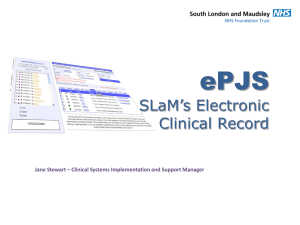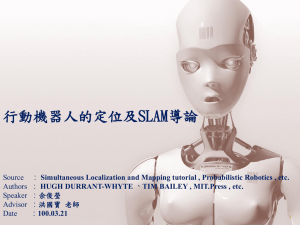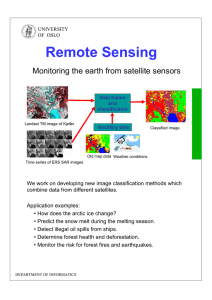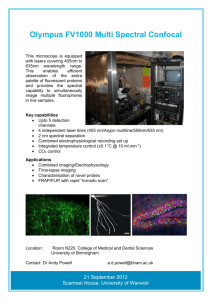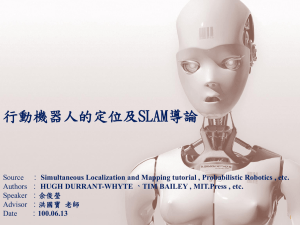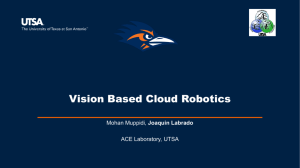A Spectral Learning Approach to Range-Only SLAM
advertisement
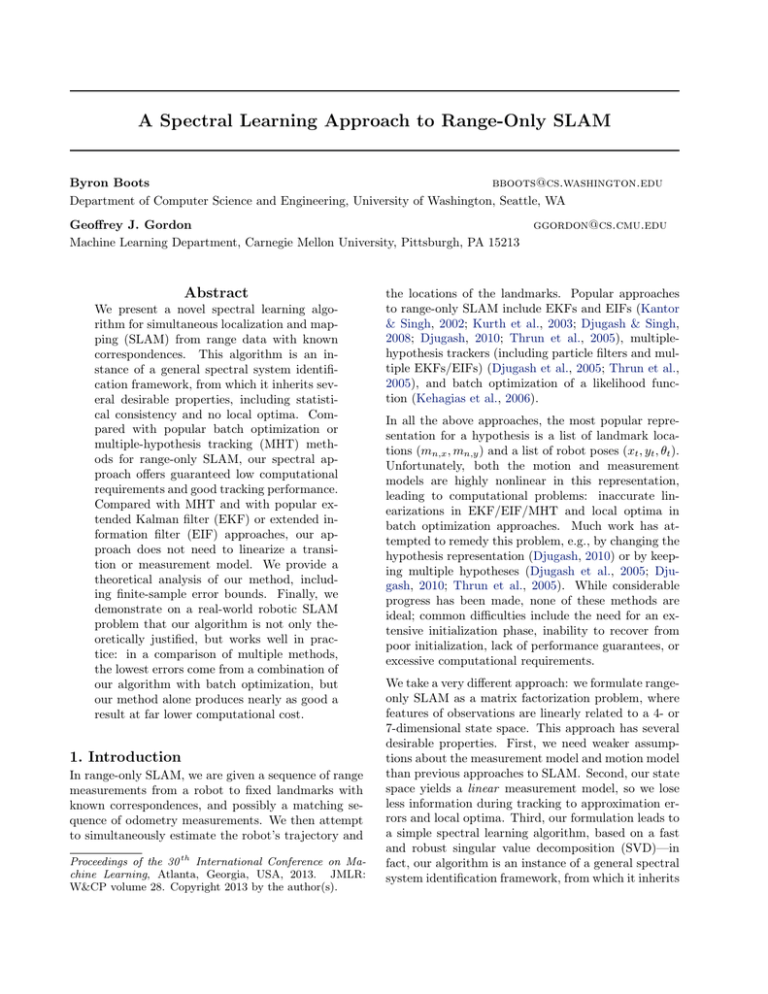
A Spectral Learning Approach to Range-Only SLAM
Byron Boots
bboots@cs.washington.edu
Department of Computer Science and Engineering, University of Washington, Seattle, WA
Geo↵rey J. Gordon
Machine Learning Department, Carnegie Mellon University, Pittsburgh, PA 15213
Abstract
We present a novel spectral learning algorithm for simultaneous localization and mapping (SLAM) from range data with known
correspondences. This algorithm is an instance of a general spectral system identification framework, from which it inherits several desirable properties, including statistical consistency and no local optima. Compared with popular batch optimization or
multiple-hypothesis tracking (MHT) methods for range-only SLAM, our spectral approach o↵ers guaranteed low computational
requirements and good tracking performance.
Compared with MHT and with popular extended Kalman filter (EKF) or extended information filter (EIF) approaches, our approach does not need to linearize a transition or measurement model. We provide a
theoretical analysis of our method, including finite-sample error bounds. Finally, we
demonstrate on a real-world robotic SLAM
problem that our algorithm is not only theoretically justified, but works well in practice: in a comparison of multiple methods,
the lowest errors come from a combination of
our algorithm with batch optimization, but
our method alone produces nearly as good a
result at far lower computational cost.
1. Introduction
In range-only SLAM, we are given a sequence of range
measurements from a robot to fixed landmarks with
known correspondences, and possibly a matching sequence of odometry measurements. We then attempt
to simultaneously estimate the robot’s trajectory and
Proceedings of the 30 th International Conference on Machine Learning, Atlanta, Georgia, USA, 2013. JMLR:
W&CP volume 28. Copyright 2013 by the author(s).
ggordon@cs.cmu.edu
the locations of the landmarks. Popular approaches
to range-only SLAM include EKFs and EIFs (Kantor
& Singh, 2002; Kurth et al., 2003; Djugash & Singh,
2008; Djugash, 2010; Thrun et al., 2005), multiplehypothesis trackers (including particle filters and multiple EKFs/EIFs) (Djugash et al., 2005; Thrun et al.,
2005), and batch optimization of a likelihood function (Kehagias et al., 2006).
In all the above approaches, the most popular representation for a hypothesis is a list of landmark locations (mn,x , mn,y ) and a list of robot poses (xt , yt , ✓t ).
Unfortunately, both the motion and measurement
models are highly nonlinear in this representation,
leading to computational problems: inaccurate linearizations in EKF/EIF/MHT and local optima in
batch optimization approaches. Much work has attempted to remedy this problem, e.g., by changing the
hypothesis representation (Djugash, 2010) or by keeping multiple hypotheses (Djugash et al., 2005; Djugash, 2010; Thrun et al., 2005). While considerable
progress has been made, none of these methods are
ideal; common difficulties include the need for an extensive initialization phase, inability to recover from
poor initialization, lack of performance guarantees, or
excessive computational requirements.
We take a very di↵erent approach: we formulate rangeonly SLAM as a matrix factorization problem, where
features of observations are linearly related to a 4- or
7-dimensional state space. This approach has several
desirable properties. First, we need weaker assumptions about the measurement model and motion model
than previous approaches to SLAM. Second, our state
space yields a linear measurement model, so we lose
less information during tracking to approximation errors and local optima. Third, our formulation leads to
a simple spectral learning algorithm, based on a fast
and robust singular value decomposition (SVD)—in
fact, our algorithm is an instance of a general spectral
system identification framework, from which it inherits
A Spectral Learning Approach to Range-Only SLAM
desirable guarantees including statistical consistency
and no local optima. Fourth, we don’t need to worry
as much as previous methods about errors such as a
consistent bias in odometry, or a receiver mounted at
a di↵erent height from the transmitters: in general,
we can learn to correct such errors automatically by
expanding the dimensionality of our state space.
As we will discuss in Section 2, our approach to SLAM
has much in common with spectral algorithms for subspace identification (Van Overschee & De Moor, 1996;
Boots et al., 2010); unlike these methods, our focus on
SLAM makes it easy to interpret our state space. Our
approach is also related to factorization-based structure from motion (Tomasi & Kanade, 1992; Triggs,
1996; Kanade & Morris, 1998), as well as to recent
dimensionality-reduction-based methods for localization and mapping (Biggs et al., 2005; Ferris et al.,
2007; Yairi, 2007). Unlike the latter approaches, which
are generally nonlinear, we only require linear dimensionality reduction. Finally, the simplest version of
our method (Sec. 3.1) is related to multidimensional
scaling (MDS). In MDS, there is no distinction between landmark positions and robot positions: we have
all-to-all range measurements for a set of landmarks,
and must recover an embedding of the landmarks.
Our smaller set of measurements introduces additional
challenges, and forces changes compared to MDS.
2. Background
There are three main pieces of relevant background:
first, the well-known solutions to range-only SLAM using variations of the extended Kalman filter and batch
optimization; second, recently-discovered spectral approaches to identifying parameters of nonlinear dynamical systems; and third, matrix factorization for
finding structure from motion in video. Below, we
will discuss the connections between these areas, and
show how they can be unified within a spectral learning framework.
2.1. Likelihood-based Range-only SLAM
The standard probabilistic model for range-only localization (Kantor & Singh, 2002; Kurth et al., 2003)
represents robot state by a vector st = [xt , yt , ✓t ]T ; the
robot’s (nonlinear) motion and observation models are
2
3
xt + vt cos(✓t )
st+1 = 4 yt + vt sin(✓t ) 5 + ✏t
(1)
✓t + !t
q
dt,n = (mn,x xt )2 + (mn,y yt )2 + ⌘t (2)
Here vt is the distance traveled, !t is the orientation
change, dt,n is the estimate of the range from the nth
landmark location (mn,x , mn,y ) to the current location
of the robot (xt , yt ), and ✏t and ⌘t are noise. (Throughout this paper we assume known correspondences,
since range sensing systems such as radio beacons
typically associate unique identifiers with each reading.) To handle SLAM rather than just localization,
we extend the state to include landmark positions:
st = [xt , yt , ✓t , m1,x , m1,y , . . . , mN,x , mN,y ]T
(3)
where N is the number of landmarks. The motion
and measurement models remain the same. Given
this model, we can use any standard optimization algorithm (such as Gauss-Newton) to fit the unknown
robot and landmark parameters by maximum likelihood. Or, we can track these parameters online using
EKFs, EIFs, or MHT methods like particle filters.
EKFs and EIFs are a popular solution for localization and mapping problems: for each new odometry
input at = [vt , !t ]T and each new measurement dt , we
propagate the estimate of the robot state and error covariance by linearizing the non-linear motion and measurement models. Unfortunately, though, range-only
SLAM is notoriously difficult for EKFs/EIFs: since
range-only sensors are not informative enough to completely localize a robot or a landmark from a small
number of readings, nonlinearities are much worse in
range-only SLAM than they are in other applications
such as range-and-bearing SLAM. In particular, if we
don’t have a sharp prior distribution for landmark positions, then after a few steps, the exact posterior becomes highly non-Gaussian and multimodal; so, any
Gaussian approximation to the posterior is necessarily
inaccurate. Furthermore, an EKF will generally not
even produce the best possible Gaussian approximation: a good linearization would tell us a lot about
the modes of the posterior, which would be equivalent to solving the original SLAM problem. So, practical applications of the EKF to range-only SLAM
attempt to delay linearization until enough information is available, e.g., via an extended initialization
phase for each landmark. Finally, Djugash et al. proposed a polar parameterization to more accurately represent the annular and multimodal distributions typically encountered in range-only SLAM. The resulting approach is called the ROP-EKF, and is shown to
outperform the ordinary (Cartesian) EKF in several
real-world problems, especially in combination with
multiple-hypothesis tracking (Djugash & Singh, 2008;
Djugash, 2010). However, the multi-hypothesis ROPEKF can be much more expensive than an EKF, and
is still a heuristic approximation to the true posterior.
2.2. Spectral System Identification
System identification algorithms attempt to learn dynamical system parameters such as a state space, a
A Spectral Learning Approach to Range-Only SLAM
dynamics model (motion model), and an observation
model (measurement model) directly from samples of
observations and actions. In the last few years, spectral system identification algorithms have become popular; these algorithms learn a state space via a spectral decomposition of a carefully designed matrix of
observable features, then find transition and observation models by linear regressions involving the learned
states. Originally, subspace identification algorithms
were almost exclusively used for linear system identification (Van Overschee & De Moor, 1996), but recently, similar spectral algorithms have been used to
learn models of partially observable nonlinear dynamical systems such as HMMs (Hsu et al., 2009; Siddiqi
et al., 2010) and PSRs (Rosencrantz et al., 2004; Boots
et al., 2010; Boots & Gordon, 2010; Boots et al., 2011).
This is a powerful and appealing approach: the resulting algorithms are statistically consistent, unlike the
popular expectation maximization (EM) algorithm,
and they are easy to implement with efficient linear
algebra operations. As we will see in Section 3, we
can view the range-only SLAM problem as an instance
of spectral state space discovery. And, the Appendix
(Sec. C) discusses how to identify transition and measurement models given the learned states. The same
properties that make spectral methods appealing for
system identification carry over to our spectral SLAM
algorithm: computational efficiency, statistical consistency, and finite-sample error bounds.
2.3. Orthographic Structure From Motion
In some ways the orthographic structure from motion
(SfM) problem in vision (Tomasi & Kanade, 1992) is
very similar to the SLAM problem: the goal is to recover scene geometry and camera rotations from a sequence of images (compare with landmark geometry
and robot poses from a sequence of range observations). And in fact, one popular solution for SfM is
very similar to the state space discovery step in spectral state space identification. The key idea in spectral
SfM is that is that an image sequence can be represented as a 2F ⇥ P measurement matrix W , containing the horizontal and vertical coordinates of P points
tracked through F frames. If the images are the result
of an orthographic camera projection, then it is possible to show that rank(W ) = 3. As a consequence, the
measurement matrix can be factored into the product of two matrices U and V , where U contains the
3d positions of the features and V contains the camera axis rotations (Tomasi & Kanade, 1992). With
respect to system identification, it is possible to interpret the matrix U as an observation model and V
as an estimate of the system state. Inspired by SfM,
we reformulate range-only SLAM problem in a similar
way in Section 3, and then similarly solve the problem
with a spectral learning algorithm.
3. State Space Discovery and Spectral
SLAM
We start with SLAM from range data without odometry. For now, we assume no noise, no missing data, and
batch processing. We will generalize below: Sec. 3.2
discusses how to recover robot orientation, Sec. 3.3 discusses noise, and Sec. 3.4 discusses missing data and
online SLAM. In the Appendix (Section C) we discuss
learning motion and measurement models.
3.1. Range-only SLAM as Matrix
Factorization
Consider the matrix Y 2 RN ⇥T of squared ranges,
with N 4 landmarks and T 4 time steps:
2 2
3
d11 d212 . . . d21T
2
2
2
7
16
6 d21 d22 . . . d2T 7
Y = 6 .
(4)
..
..
.. 7
2 4 ..
.
.
. 5
d2N 1 d2N 2 . . . d2N T
where dn,t is the measured distance from the robot to
landmark n at time step t. The most basic version of
our spectral SLAM method relies on the insight that Y
factors according to robot position (xt , yt ) and landmark position (mn,x , mn,y ). To see why, note
d2n,t = (m2n,x+m2n,y ) 2mn,x ·xt 2mn,y ·yt+(x2t +yt2 ) (5)
If we write Cn = [(m2n,x + m2n,y )/2, mn,x , mn,y , 1]T and
Xt = [1, xt , yt , (x2t + yt2 )/2]T , it is easy to see that
d2n,t = 2CnT Xt . So, Y factors as Y = CX, where
C 2 RN ⇥4 contains the positions of landmarks, and
X 2 R4⇥T contains the positions of the robot over
time:
2
3
(m21,x + m21,y )/2 m1,x m1,y 1
6 (m22,x + m22,y )/2 m2,x m2,y 1 7
6
7
C=6
..
..
..
.. 7 (6)
4
.
.
.
. 5
2
2
(mN,x + mN,y )/2 mN,x mN,y 1
2
3
1
...
1
6
7
x1
...
xT
7
X=6
(7)
4
5
y1
...
yT
(x21 + y12 )/2 . . . (x2T + yT2 )/2
If we can recover C and X, we can read o↵ the solution to the SLAM problem. The fact that Y ’s rank is
only 4 suggests that we might be able to use a rankrevealing factorization of Y , such as the singular value
decomposition, to find C and X. Unfortunately, such
a factorization only determines C and X up to a linear
transform: given an invertible matrix S, we can write
A Spectral Learning Approach to Range-Only SLAM
A. start position
B.103
2
true Landmark
1 est. Landmark
0
10
ings simultaneously. We do so by adding more features to our measurement matrix: di↵erences between
successive pairs of squared distances, scaled by velocity (which we can estimate from odometry). Since we
need pairs of time steps, we now have Y 2 R2N ⇥T 1 :
convergence of
measurment model
(log-log)
1
10
true Path
est. Path
0
2
10
−1
10
−1
−2
−1
0
1
2
10
101
102
103
Figure 1. Spectral SLAM on simulated data. See Section D
for details. A.) Randomly generated landmarks (6 of them)
and robot path through the environment (500 timesteps).
A SVD of the squared distance matrix recovers a linear
transform of the landmark and robot positions. Given
the coordinates of 4 landmarks, we can recover the landmark and robot positions exactly; or, since 500
8, we
can recover positions up to an orthogonal transform with
no additional information. Despite noisy observations, the
robot recovers the true path and landmark positions with
very high accuracy. B.) The convergence of the observation
b mean Frobenius-norm error vs. number of range
model C:
readings received, averaged over 1000 randomly generated
pairs of robot paths and environments. Error bars indicate
95% confidence intervals.
Y = CX = CS 1 SX. Therefore, factorization can
only hope to recover U = CS 1 and V = SX.
To upgrade the factors U and V to a full metric map,
we have two options. If global position estimates are
available for at least four landmarks, we can learn
the transform S via linear regression, and so recover
the original C and X. This method works as long as
we know at least four landmark positions. Figure 1A
shows a simulated example.
On the other hand, if no global positions are known,
the best we can hope to do is recover landmark and
robot positions up to an orthogonal transform (translation, rotation, and reflection). It turns out that
Eq. (7) provides enough additional geometric constraints to do so: in the Appendix (Sec. A) we show
that, if we have
8 time steps and
8 landmarks,
we can compute the metric upgrade in closed form.
The idea is to fit a quadratic surface to the rows of U ,
then change coordinates so that the surface becomes
the function in (7). (By contrast, the usual metric upgrade for orthographic structure from motion (Tomasi
& Kanade, 1992), which uses the constraint that camera projection matrices are orthogonal, requires a nonlinear optimization.)
3.2. SLAM with Headings
In addition to location, we often want the robot’s
global heading ✓. We could get headings by postprocessing our learned positions; but in practice we
can reduce variance by learning positions and head-
6
6
6
6
16
Y = 6
26
6
6
6
4
d211
..
.
d2N 1
d212
..
.
d2N 2
2
d2
12 d11
v1
2
d2
13 d12
v2
..
.
...
..
.
...
...
..
.
..
.
d2
N2
d2
N1
v1
d2
N2
d2
N3
v2
...
d21T
..
.
d2N T
3
1
1
2
d2
1T d1T 1
vT 1
..
.
d2
NT
d2
NT
vT 1
1
7
7
7
7
7
7 (8)
7
7
7
7
5
As before, we can factor Y into a state matrix and a
landmark matrix. The key observation is that we can
write the new features in terms of cos(✓) and sin(✓):
d2n,t+1 d2n,t
=
2vt
mn,x (xt+1 xt ) mn,y (yt+1
vt
vt
2
x2t+1 x2t + yt+1
yt2
+
2vt
= mn,x cos(✓t ) mn,y sin(✓t )
+
x2t+1
2
x2t + yt+1
2vt
yt2
yt )
(9)
From Eq. 5 and Eq. 9 it is easy to see that Y is rank
7: we have Y = CX, where C 2 RN ⇥7 contains functions of landmark positions and X 2 R7⇥T contains
functions of robot state,
2
(m21,x + m21,y )/2 m1,x m1,y
6
..
..
..
6
.
.
.
6
6(m2 + m2 )/2 mN,x mN,y
N,x
N,y
6
C=6
0
0
0
6
6
.
.
..
..
..
4
.
0
0
0
2
6
6
6
6
X=6
6
6
6
4
1
x1
y1
(x21 + y12 )/2
cos(✓1 )
sin(✓1 )
x2
2
2
x2
1 +y2
2v1
2
y1
...
...
...
...
...
...
...
(x2T
x2
T
1
0
0
..
..
..
.
.
.
1
0
0
0 m1,x m1,y
..
..
..
.
.
.
0 mN,x mN,y
1
xT 1
yT 1
2
1 + yT 1 )/2
cos(✓T 1 )
sin(✓T 1 )
x2
T
2
1 +yT
2vT 1
2
yT
1
3
7
7
7
7
7
7
7
7
5
3
0
.. 7
. 7
7
0 7
7
1 7
7
.. 7
. 5
1
(10)
(11)
As with the basic SLAM algorithm in Section 3.1, we
can factor Y using SVD, this time keeping 7 singular
values. Then we can do a metric upgrade as before to
get robot positions (see Appendix, Sec. A for details);
finally we can recover headings as angles between successive positions.
3.3. A Spectral SLAM Algorithm
The matrix factorizations of Secs. 3.1 and 3.2 suggest
a straightforward SLAM algorithm, Alg. 1: build an
A Spectral Learning Approach to Range-Only SLAM
Algorithm 1 Spectral SLAM
In: i.i.d. pairs of observations {ot , at }Tt=1 ; optional:
measurement model for 4 landmarks C1:4
b robot locations
Out: measurement model (map) C,
b
X (the tth column is location at time t)
1: Collect observations and odometry into a matrix
Yb (Eq. 8)
2: Find the the top 7 singular values and vectors:
b , ⇤,
b Vb > i
hU
SVD(Yb , 7)
3: Find the transformed measurement matrix
b 1=U
b and robot states S X
b =⇤
b Vb > via linear
CS
b
regression (from C1:4 to C1:4 ) or metric upgrade
(see Appendix).
empirical estimate Yb of Y by sampling observations as
the robot traverses its environment, then apply a rank
k = 7 thin SVD, discarding the remaining singular
values to suppress noise.
b , ⇤,
b Vb > i
hU
SVD(Yb , 7)
(12)
b are
Following Section 3.2, the left singular vectors U
an estimate of our transformed measurement matrix
b Vb >
CS 1 , and the weighted right singular vectors ⇤
are an estimate of our transformed robot state SX.
We can then perform metric upgrade as before.
Statistical Consistency and Sample Complexity Let M 2 RN ⇥N be the true observation covariance for a randomly sampled robot position, and let
c = 1 Yb Yb > be the empirical covariance estimated
M
T
from T observations. Then the true and estimated
measurement models are the top singular vectors of M
c. Assuming that the noise in M
c is zero-mean,
and M
as we include more data in our averages, we will show
below that the law of large numbers guarantees that
c converges to the true covariance M . That is, our
M
learning algorithm is consistent. (The estimated robot
positions will typically not converge, since we typically have a bounded e↵ective number of observations
relevant to each robot position. But, as we see each
landmark again and again, the robot position errors
will average out, and we will recover the true map.)
In more detail, we can give finite-sample bounds on
the error in recovering the true factors. For simplicity
of presentation we assume that noise is i.i.d., although
our algorithm will work for any zero-mean noise process with a finite mixing time. (The error bounds
will of course become weaker in proportion to mixing
time, since we gain less new information per observation.) The argument (see the Appendix, Sec. B, for details) has two pieces: standard concentration bounds
show that each element of our estimated covariance
approaches its population value; then the continuity
of the SVD shows that the learned subspace also approaches its true value. The final bound is:
q
)
N c 2 log(T
T
|| sin ||2
(13)
where is the vector of canonical angles between the
learned subspace and the true one, c is a constant depending on our error distribution, and is the true
smallest nonzero eigenvalue of the covariance. In particular, this bound means that the sample complexity
is Õ(⇣ 2 ) to achieve error ⇣.
3.4. Extensions
Missing data So far we have assumed that we receive range readings to all landmarks at each time
step. In practice this assumption is rarely satisfied:
we may receive range readings asynchronously, some
range readings may be missing entirely, and it is often
the case that odometry data is sampled faster than
range readings. Here we outline two methods for overcoming this practical difficulty.
First, if a relatively small number of observations are
missing, we can use standard approaches for factorization with missing data. For example, probabilistic
PCA (Tipping & Bishop, 1999) estimates the missing entries via the EM algorithm, and matrix completion (Candès & Plan, 2009) uses a trace-norm penalty
to recover a low-rank factorization with high probability. However, for range-only data, often the fraction of
missing data is high and the missing values are structural rather than random.
The second approach is interpolation: we divide the
data into overlapping subsets and then use local odometry information to interpolate the range data within
each subset. To interpolate the data, we estimate a
robot path by dead reckoning. For each point in the
dead reckoning path we build the feature representation [1, x, y, (x2 + y 2 )/2]> . We then learn a linear
model that predicts a squared range reading from these
features (for the data points where range is available),
as in Eq. 5. Next we predict the squared range along
the entire path. Finally we build the matrix Yb by averaging the locally interpolated range readings. This
linear approach works much better in practice than the
fully probabilistic approaches mentioned above, and
was used in our experiments in Section 4.
Online Spectral SLAM The algorithms developed
in this section so far have had an important drawback:
unlike many SLAM algorithms, they are batch methods not online ones. The extension to online SLAM
A Spectral Learning Approach to Range-Only SLAM
is straightforward: instead of first estimating Yb and
then performing a SVD, we sequentially estimate our
b , ⇤,
b Vb > i via online SVD (Brand, 2006; Boots
factors hU
et al., 2011).
Robot Filtering and System Identification So
far, our algorithms have not directly used (or needed)
a robot motion model in the learned state space. However, an explicit motion model is required if we want
to predict future sensor readings or plan a course of
action. We have two choices: we can derive a motion
model from our learned transformation S between latent states and physical locations, or we can learn a
motion model directly from data using spectral system identification. More details about both of these
approaches can be found in the Appendix, Sec. C.
4. Experimental Results
We perform several SLAM and robot navigation experiments to illustrate and test the ideas proposed in this
paper. For synthetic experiments that illustrate convergence and show how our methods work in theory,
see Fig. 1. We also demonstrate our algorithm on data
collected from a real-world robotic system with substantial amounts of missing data. Experiments were
performed in Matlab, on a 2.66 GHz Intel Core i7 computer with 8 GB of RAM. In contrast to batch nonlinear optimization approaches to SLAM, the spectral
learning methods described in this paper are very fast,
usually taking less than a second to run.
We used two freely available range-only SLAM benchmark data sets collected from an autonomous lawn
mowing robot (Djugash, 2010), shown in Fig. 2A.1
These “Plaza” datasets were collected via radio nodes
from Multispectral Solutions that use time-of-flight of
ultra-wide-band signals to provide inter-node ranging
measurements and the unique ID of the radio nodes.
(Additional details can be found in (Djugash, 2010).)
In “Plaza 1,” the robot travelled 1.9km, occupied 9,658
distinct poses, and received 3,529 range measurements.
The path taken is a typical lawn mowing pattern that
balances left turns with an equal number of right turns;
this type of pattern minimizes the e↵ect of heading error. In “Plaza 2,” the robot travelled 1.3km, occupied
4,091 poses, and received 1,816 range measurements.
The path taken is a loop which amplifies the e↵ect
of heading error. The two data sets were both very
sparse, with approximately 11 time steps (and up to
500 steps) between range readings for the worst landmark. We first interpolated the missing range readings
with the method of Section 3.4. Then we applied the
rank-7 spectral SLAM algorithm of Section 3.3; the
1
http://www.frc.ri.cmu.edu...
.../projects/emergencyresponse/RangeData/index.html
results are depicted in Figure 2B-C. Qualitatively, we
see that the robot’s localization path conforms to the
true path.
In addition to the qualitative results, we quantitatively compared spectral SLAM to a number of different competing range-only SLAM algorithms which
have been used on the benchmark data sets. The localization root mean squared error (RMSE) in meters
for each algorithm is shown in Figure 3. The baseline
is dead reckoning (using only the robot’s odometry
information). Next are several standard online rangeonly SLAM algorithms, including the Cartesian EKF,
FastSLAM (Montemerlo et al., 2002) with 5,000 particles, and the ROP-EKF algorithm (Djugash & Singh,
2008), which achieved the best prior results on the
benchmark datasets. These previous results only reported the RMSE for the last 10% of the path, which
is the best 10% of the path (since it gives the most
time to recover from initialization problems). The full
path localization error can be considerably worse, particularly for the initial portion of the path—see Fig. 5
(right) of (Djugash & Singh, 2008).
We also compared to batch nonlinear optimization,
via the quasi-Newton BFGS method as implemented
in Matlab’s fminunc (see (Kehagias et al., 2006) for
details).2 This approach to solving the range-only
SLAM problem can be very data efficient, but is subject to local optima and is computationally intensive.
We followed the suggestions of (Kehagias et al., 2006)
and initialized with the dead-reckoning estimate of the
robot’s path. For Plaza 1 and Plaza 2, the algorithm
took roughly 2.5 hours and 45 minutes to converge
respectively.
Finally, we ran our spectral SLAM algorithm on the
same data sets. In contrast to BFGS, spectral SLAM
is statistically consistent, and much faster: the bulk
of the computation is the fixed-rank SVD, so the time
complexity of the algorithm is O((2N )2 T ) where N
is the number of landmarks and T is the number of
time steps. Empirically, spectral SLAM produced results that were comparable to batch optimization in
3-4 orders of magnitude less time (see Figure 3).
Spectral SLAM can also be used as an initialization procedure for nonlinear batch optimization. This
strategy combines the best of both algorithms by allowing the locally optimal nonlinear optimization procedure to start from a theoretically guaranteed good
starting point. Therefore, the local optimum found by
2
We also tried Preconditioned Conjugate Gradient and
Levenberg–Marquardt, but found BFGS to be the most
efficient and stable nonlinear optimization procedure for
this particular problem.
A Spectral Learning Approach to Range-Only SLAM
A.
B. Plaza
1
autonomous lawn mower
C. Plaza 2
60
60
50
50
40
40
30
30
20
20
10
dead reackoning Path
10
true Path
0
0
est. Path
−10
true Landmark
−10
20
−40
−20
0
est. Landmark
−60
−40
−20
0
Figure 2. The autonomous lawn mower and spectral SLAM. A.) The robotic lawn mower platform. B.) In the first
experiment, the robot traveled 1.9km receiving occupying 9,658 poses and receiving 3,529 range measurements. This path
minimizes the e↵ect of heading error by balancing the number of left turns with an equal number of right turns in the
robot’s odometry (a commonly used path pattern in lawn mowing applications). The light blue path indicates the robot’s
true path in the environment, light purple indicates dead-reckoning path, and dark blue indicates the spectral SLAM
localization result. C.) In the second experiment, the robot traveled 1.3km occupying 4,091 poses and receiving 1,816
range measurements. This path highlights the e↵ect of heading error on dead reckoning performance by turning in the
same direction repeatedly. Again, spectral SLAM is able to accurately recover the robot’s path.
nonlinear batch optimization should be no worse than
the spectral SLAM solution and likely much better
than the batch optimization seeded by dead-reckoning.
Empirically, we found this to be the case (Figure 3).
If time and computational resources are scarce, then
we believe that spectral SLAM is clearly the best approach; if computation is not an issue, the best results
will likely be found by refining the spectral SLAM solution using a nonlinear batch optimization procedure.
5. Conclusion
We proposed a novel solution for the range-only SLAM
problem that di↵ers substantially from previous approaches. The essence of this new approach is to formulate SLAM as a factorization problem, which allows
us to derive a local-minimum free spectral learning algorithm that is closely related to SfM and recent spectral methods for system identification. Additionally,
we discuss how to contend with missing data and how
to derive an online algorithm. We are able to prove
statistical consistency and sample complexity bounds
for our algorithm, while getting competitive error in
practice compared to methods like full batch optimization of the likelihood on several benchmark data sets.
Finally, we show that our algorithm is fast: we analyze
the time complexity and demonstrate empirically that
our algorithm can be orders of magnitude faster than
competing nonlinear batch optimization procedures.
Acknowledgements
Byron Boots and Geo↵rey J. Gordon were supported
by ONR MURI grant N00014-09-1-1052. Byron Boots
was supported by NSF grant EEEC-0540865.
References
Biggs, Michael, Ghodsi, Ali, Wilkinson, Dana, and Bowling, Michael. Action respecting embedding. In In Proceedings of the Twenty-Second International Conference
on Machine Learning, pp. 65–72, 2005.
Boots, Byron and Gordon, Geo↵. Predictive state temporal
di↵erence learning. In La↵erty, J., Williams, C. K. I.,
Shawe-Taylor, J., Zemel, R.S., and Culotta, A. (eds.),
Advances in Neural Information Processing Systems 23,
pp. 271–279. 2010.
Boots, Byron, Siddiqi, Sajid M., and Gordon, Geo↵rey J.
Closing the learning-planning loop with predictive state
representations. In Proceedings of Robotics: Science and
Systems VI, 2010.
Boots, Byron, Siddiqi, Sajid, and Gordon, Geo↵rey. An online spectral learning algorithm for partially observable
nonlinear dynamical systems. In Proceedings of the 25th
National Conference on Artificial Intelligence (AAAI2011), 2011.
Brand, Matthew. Fast low-rank modifications of the thin
singular value decomposition. Linear Algebra and its
Applications, 415(1):20–30, 2006.
Candès, Emmanuel J. and Plan, Yaniv. Matrix completion
with noise. CoRR, abs/0903.3131, 2009.
Djugash, Joseph. Geolocation with range: Robustness, efficiency and scalability. PhD. Thesis, Carnegie Mellon
University, 2010.
Djugash, Joseph and Singh, Sanjiv. A robust method of
localization and mapping using only range. In International Symposium on Experimental Robotics, July 2008.
Djugash, Joseph, Singh, Sanjiv, and Corke, Peter Ian. Further results with localization and mapping using range
from radio. In International Conference on Field and
Service Robotics (FSR ’05), July 2005.
A Spectral Learning Approach to Range-Only SLAM
Method
Dead Reckoning (full path)
Cartesian EKF (last, best 10%)
FastSLAM (last, best 10%)
ROP EKF (last, best 10%)
Batch Opt. (worst 10%)
Batch Opt. (last 10%)
Batch Opt. (best 10%)
Batch Opt. (full path)
Spectral SLAM (worst 10%)
Spectral SLAM (last 10%)
Spectral SLAM (best 10%)
Spectral SLAM (full path)
Spectral + Batch Optimization (worst 10%)
Spectral + Batch Optimization (last 10%)
Spectral + Batch Optimization (best 10%)
Spectral + Batch Optimization (full path)
Plaza 1
15.92m
0.94m
0.73m
0.65m
1.04m
1.01m
0.56m
0.79m
1.01m
0.98m
0.59m
0.79m
0.89m
0.81m
0.54m
0.69m
Plaza 2
27.28m
0.92m
1.14m
0.87m
0.45m
0.45m
0.20m
0.33m
0.51m
0.51m
0.22m
0.35m
0.40m
0.32m
0.18m
0.30m
Runtime (seconds)
Batch Opt.
Spectral SLAM
9264.55
~
~
2357.09
~
~
0.73
Plaza 1
0.51
Plaza 2
Figure 3. Comparison of Range-Only SLAM Algorithms. The table shows Localization RMSE. Spectral SLAM has
localization accuracy comparable to batch optimization on its own. The best results (boldface entries) are obtained by
initializing nonlinear batch optimization with the spectral SLAM solution. The graph compares runtime of Gauss-Newton
batch optimization with spectral SLAM. Empirically, spectral SLAM is 3-4 orders of magnitude faster than full batch
optimization of the likelihood on the autonomous lawnmower datasets.
Ferris, Brian, Fox, Dieter, and Lawrence, Neil. WiFiSLAM using Gaussian process latent variable models.
In Proceedings of the 20th international joint conference
on Artifical intelligence, IJCAI’07, pp. 2480–2485, San
Francisco, CA, USA, 2007. Morgan Kaufmann Publishers Inc.
Hsu, Daniel, Kakade, Sham, and Zhang, Tong. A spectral
algorithm for learning hidden Markov models. In COLT,
2009.
Kanade, T. and Morris, D.D. Factorization methods
for structure from motion. Philosophical Transactions
of the Royal Society of London. Series A: Mathematical, Physical and Engineering Sciences, 356(1740):1153–
1173, 1998.
Kantor, George A and Singh, Sanjiv. Preliminary results
in range-only localization and mapping. In Proceedings
of the IEEE Conference on Robotics and Automation
(ICRA ’02), volume 2, pp. 1818 – 1823, May 2002.
Kehagias, Athanasios, Djugash, Joseph, and Singh, Sanjiv.
Range-only SLAM with interpolated range data. Technical Report CMU-RI-TR-06-26, Robotics Institute, May
2006.
Kurth, Derek, Kantor, George A, and Singh, Sanjiv. Experimental results in range-only localization with radio.
In 2003 IEEE/RSJ International Conference on Intelligent Robots and Systems (IROS ’03), volume 1, pp. 974
– 979, October 2003.
Montemerlo, Michael, Thrun, Sebastian, Koller, Daphne,
and Wegbreit, Ben. FastSLAM: A factored solution to
the simultaneous localization and mapping problem. In
In Proceedings of the AAAI National Conference on Artificial Intelligence, pp. 593–598. AAAI, 2002.
Rosencrantz, Matthew, Gordon, Geo↵rey J., and Thrun,
Sebastian. Learning low dimensional predictive representations. In Proc. ICML, 2004.
Siddiqi, Sajid, Boots, Byron, and Gordon, Geo↵rey J.
Reduced-rank hidden Markov models. In Proceedings
of the Thirteenth International Conference on Artificial
Intelligence and Statistics (AISTATS-2010), 2010.
Thrun, Sebastian, Burgard, Wolfram, and Fox, Dieter. Probabilistic Robotics (Intelligent Robotics and
Autonomous Agents). The MIT Press, 2005. ISBN
0262201623.
Tipping, Michael E. and Bishop, Chris M. Probabilistic
principal component analysis. Journal of the Royal Statistical Society, Series B, 61:611–622, 1999.
Tomasi, Carlo and Kanade, Takeo. Shape and motion
from image streams under orthography: a factorization
method. International Journal of Computer Vision, 9:
137–154, 1992.
Triggs, B. Factorization methods for projective structure
and motion. In Computer Vision and Pattern Recognition, 1996. Proceedings CVPR’96, 1996 IEEE Computer
Society Conference on, pp. 845–851. IEEE, 1996.
Van Overschee, P. and De Moor, B. Subspace Identification
for Linear Systems: Theory, Implementation, Applications. Kluwer, 1996.
Yairi, Takehisa. Map building without localization by dimensionality reduction techniques. In Proceedings of
the 24th international conference on Machine learning,
ICML ’07, pp. 1071–1078, New York, NY, USA, 2007.
ACM.
